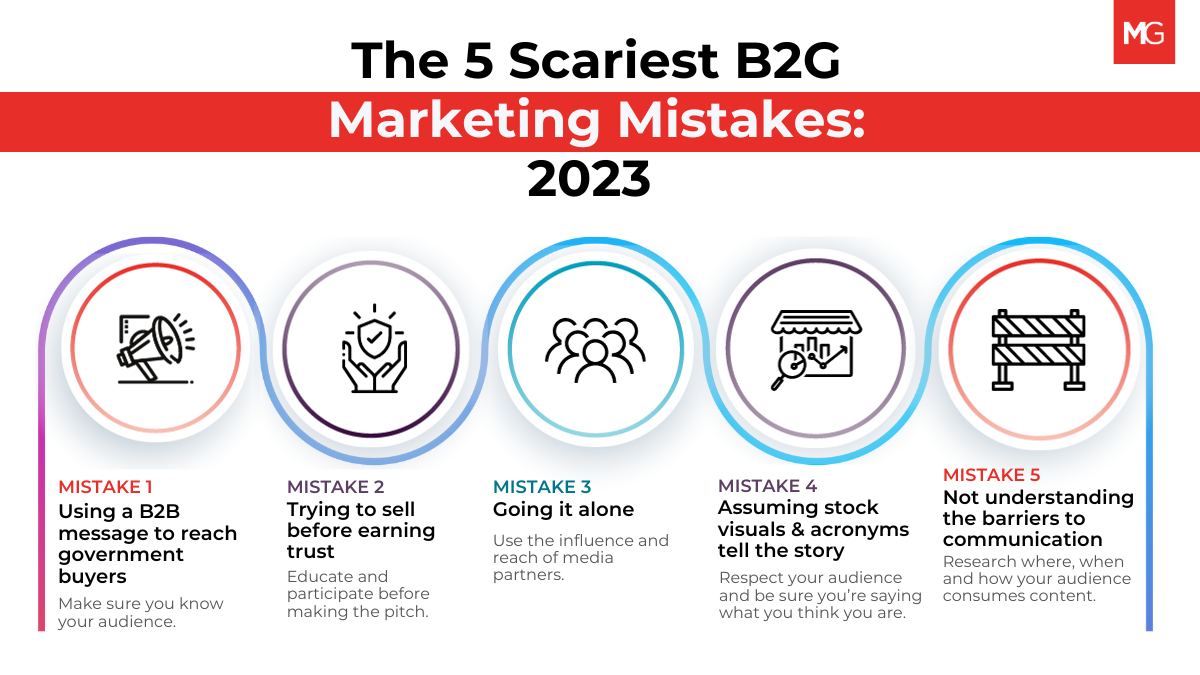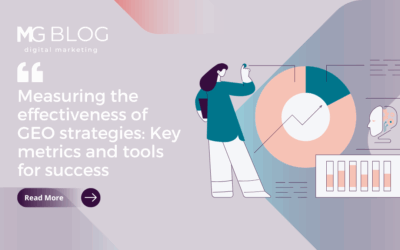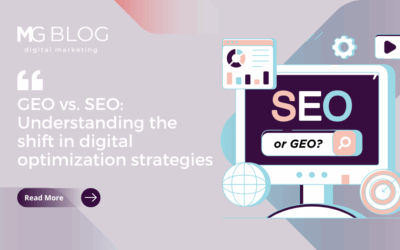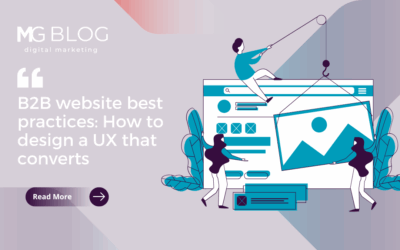
Government marketing poses a unique challenge. Not only do you have to talk the government talk, but marketers must also understand how to navigate the federal purchasing cycle, build trust with key decision-makers, optimize for the right communication channel, and more.
Having worked in this space for over two decades, I’ve seen a lot of government marketing campaigns go wrong. I’ve also seen quite a few go right.
I recently joined Merritt Group’s podcast, Lay of the Brand, to talk through some of the biggest mistakes that B2G marketers make, and what they should be doing instead. Keep reading for our top takeaways. For more information on what NOT to do when trying to reach federal decision-makers, listen to the full Lay of the Brand episode.
The 5 Most Avoidable Mistakes In Government Marketing
1. Taking a generic B2B message to government audiences: I was at a FedScoop FedTalks event a few years ago, and a global tech leader was introducing themselves to the federal IT market. This was their first big investment and rather than crafting a customized message that spoke to their target audience, they walked through a generic B2B sales deck. People literally ended up walking out of the session. And I think that experience perfectly highlights a common mistake I’ve seen government marketers make, which is trying to reach government buyers with a non-B2G message.
This was a huge miss given the amount of time, effort, and budget that goes into these kinds of sponsorship packages. It also created a negative brand perception right out of the gate. Great B2G marketing starts with understanding the customer challenge. A lot of government agencies talk about wanting to modernize and embrace commercial innovation, but that doesn’t mean marketers should pitch them in a B2B way. Instead, we need to talk about how the solution or technology can be implemented realistically within the context of the mission.
2. Selling before earning trust: This is probably one of the biggest mistakes a government marketing agency can make. B2G sales cycles are much longer and much more complicated than B2B—we’re talking 12, 18, and even 24-month, multimillion-dollar procurement cycles on enterprise-wide technology solutions.
A procurement process of that scope requires a lot of checks and balances. You can’t deliver your sales pitch until federal decision-makers know who you are, what you do, whether or not you’re committed to this market, and that you understand their mission. You have to establish that trust first, otherwise, your message won’t resonate. It’s like going on a first date and proposing before you even get the check—it’s probably not going to work out in your favor.
Rather than focusing on gathering leads or accelerating procurement cycles, try leading with education. Focus on creating content that’s relevant over an extended period of time and building that relationship with your target audience. In particular, I recommend working with the frontline folks—people like the sales, business development, and capture teams—who understand and can speak to that specific agency or organization’s pain points. That will allow you to create a partnership rather than a transactional, one-and-done relationship.
3. Trying to “go it alone:” A lot of companies that are new to the government marketing space make the mistake of trying to go it alone. But in doing so, they miss out on the tremendous value that more established organizations have to offer.
Consider a global B2B leader that decides to prioritize federal for the first time. One strategy that I see a lot is trying to build a custom federal event from the ground up. It’s not a terrible idea—events are a great tactic in the government market—but by going the build versus buy route, you miss out on an established audience base and built-in credibility. Associations like AFCEA and media groups like GovExec already have their own events that are known and trusted by federal audiences, so why not use them? Many of these organizations can bring actual government leaders and speakers to the table in a way that vendors can’t. B2B companies might have name recognition in commercial spaces, but that doesn’t always translate well in the public sector. Federal audiences have to trust that you can solve government-focused problems before they’re willing to work with you.
I’ve seen a similar issue with companies trying to stand up dedicated blog sites in order to share thought leadership content. Blogs are an excellent repository for resources, but it’s unlikely that federal buyers will visit a brand-new site that they’ve never seen before. Rather than putting forth the effort in promotion and social to drive people back to a place they don’t go organically, focus on getting that thought leadership onto a platform that already has your target audience.
4. Relying on stock visuals and acronyms: Using the word “mission” and showing a generic image of Capitol Hill isn’t going to move the needle on government marketing. Too often, organizations fall into the trap of trying to fake an understanding of the federal market—whether through an incorrectly used acronym or a stock picture that shows an outdated military uniform. There are a lot of potential pitfalls that may not be as obvious to someone who doesn’t work in the federal space on a daily basis, so finding the right expert is key.
This goes back to what I mentioned earlier about not relying on B2B messaging when speaking to B2G audiences. If you don’t understand your core customers—where they work, how they dress, what kind of equipment they use—you risk alienating or, even worse, offending them.
5. Failing to understand unique B2G communication barriers: Finally, there are technological barriers that can prevent certain government audiences from receiving information. I’ve seen plenty of B2B companies come into this space and default to using email marketing campaigns as one of their primary lead-generation efforts. However, depending on the agency, some of these folks can’t receive HTML emails due to security concerns.
We see the same issue with certain social media platforms and internet access. Agency personnel are not going to be able to access that content from their government-issued device or while they’re on-premises. Government marketers need to be really thoughtful about what people are allowed to consume during their workday. That’s why it’s so important to make sure you’re working with someone who understands those gaps and knows where the barriers are. For example, we’ve spoken with Mark Amtower of Amtower & Company in the past about the benefits of using LinkedIn compared to other social platforms when conducting a B2G ABM campaign. It’s all about knowing where your audience already is and what you can and can’t do to reach them.

What common government marketing mistakes have you seen? For more information on B2G best practices, check out our Government page and listen to my full episode on Lay of the Brand.



